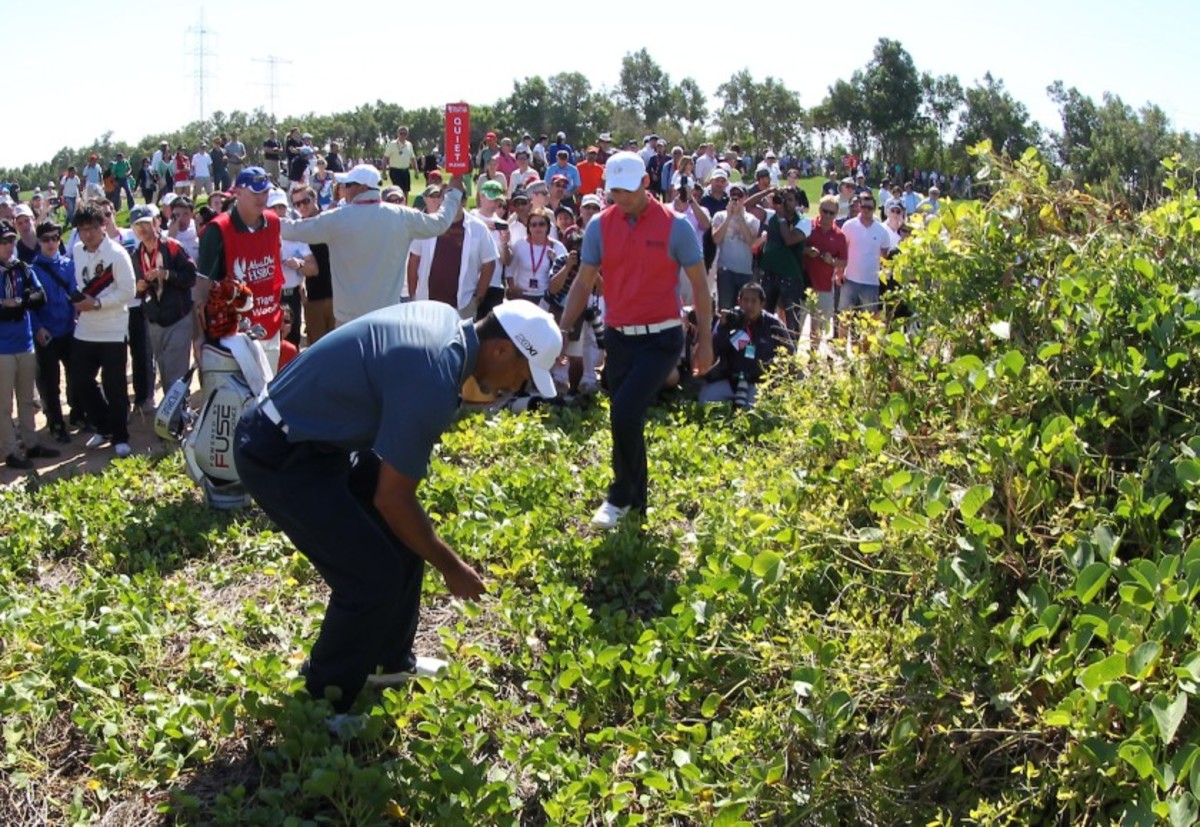Golf News: Learn the Rules of Golf, especially the new ones

A wee alarm bell started ringing in my head when Tiger Woods got relief from an embedded ball. I knew something wasn’t right. Sadly, I was proved correct.
It was yet another experience that made me ask a perennial question: Why don’t tour pros know the rules any better than they do?

Woods was battling to make the cut in the second round of the 2013 Abu Dhabi HSBC Golf Championship when he drove his ball into a sandy, scrubby area to the right of the fifth hole. It came to rest on creeping vegetation. Woods was playing with Rory McIlroy and three-time Abu Dhabi champion Martin Kaymer, who was marking Woods’ card.
Woods consulted with Kaymer, who gave him the thumbs up. Woods took a drop and hit his approach shot onto the green.
I consulted with TV commentator Richard Boxall. The 1990 Italian Open winner told me that Woods got relief for an embedded ball. The European Tour and PGA Tour operated a local rule for embedded balls anywhere through the green in those days, unlike amateurs who got relief only for an embedded ball in closely mown areas, i.e., the fairway.
I wasn’t convinced because I knew that what was then Rule 25-2 had an exception for sand. European Tour referee Miguel Vidor was stationed between the fifth and sixth holes, and I asked him for clarification. He said Woods was within his rights to take the drop. I queried him further about the ball being in sand, and Vidor asked me to take him to the actual spot.
I did, and Vidor again told me there was nothing wrong with the drop. I put it down to being part of learning about the rules and went on my way.
Vidor clearly had second thoughts because he consulted with European Tour chief referee Andy McFee, who agreed with me. McFee informed Woods on the 11th hole that he’d incurred a two-shot penalty on the fifth, later saying: “It’s very specific, that rule, and it refers to ground other than sand.”
Woods missed the cut as a result, and I received a torrent of abuse on social media for doing my job. Incidentally, the same rule applies nowadays, though it is now Rule 16-3 since the rules were changed effective in January 2019.
I’m fairly lucky inasmuch as I have a good working knowledge of the Rules of Golf, good enough to pass the R&A Rules of Golf and Refereeing exam. I’m no McFee or John Paramor. I got a mark of only 74 percent, which means I’m wrong 26 percent of the time.
We can cut Woods some slack for his Abu Dhabi misstep since it did/does border on the obscure sides of the Rules of Golf. However, my basic tenet holds true: More touring pros could help themselves by learning the rules that govern their game.
Can you imagine a tax accountant not knowing the tax codes, or a banker not knowing the banking laws?
I’ve seen players ask for rulings that 24-handicappers would be embarrassed to seek. I watched Se Ri Pak hit her second shot into the Swilcan Burn, golf’s original water hazard, on the Old Course’s first hole during the 2007 Women’s British Open at St. Andrews. Pak called for a ruling while the other two members of the group finished the hole. It took a referee about 15 minutes to come from another part of the course to tell Pak in about 30 seconds where she should drop her ball. Members of the Scottish gallery were fuming that Pak didn’t make the ruling herself.
During one Dubai Desert Classic, I watched Joost Luiten tell Stephen Gallacher that he was going to call for a referee because his ball was lying on a cart path. Gallacher told him where to drop the ball, but from the look of contempt on his face he wanted to tell Luiten something else.
Not all players are ignorant of the laws that govern their game. Annika Sorenstam went to the effort of taking a rules exam when she was in her pomp. The late Seve Ballesteros was pretty hot on the laws, too. Both knew that knowledge is king, that the rules are there to help players and not just punish them. Mind you, Ballesteros wasn’t above trying to coax officials to give him rulings. Google “Seve Ballesteros” and “John Paramor” and “Valderrama” for proof.
There are only 24 rules now compared with the previous 34. Players will spend eight hours a day working on every facet of their game but won’t take 15 minutes to read the rules. It’s not as if they’re short of down time in hotels, long flights and courtesy cars. Lately, they’ve got far more time off than usual.
True, players have been reluctant to take action in the past because it seemed as if a 1-millimeter infringement sometimes resulted in a two-shot penalty, or even disqualification. Thankfully, the new rules are far more lenient on that side of things.
Paramor once said that if players just learned the definitions, then that would be a good starting point. I don’t see why they don’t go further. As R&A director of rules David Rickman says: “One rule a day, and you’ll know a lot in a month.”
There’s never been a better time for touring pros and other golfers to put that advice to use.
Sign up to receive the Morning Read newsletter, along with Where To Golf Next and The Equipment Insider.
